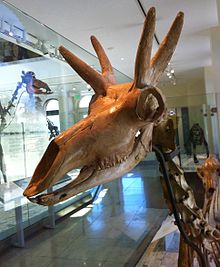Antilocapridae
Appearance
| Antilocapridae Temporal range:
| |
|---|---|

| |
| Pronghorns in Fort Keogh, Montana | |
| Scientific classification | |
| Domain: | Eukaryota |
| Kingdom: | Animalia |
| Phylum: | Chordata |
| Class: | Mammalia |
| Order: | Artiodactyla |
| Suborder: | Ruminantia |
| Infraorder: | Pecora |
| Family: | Antilocapridae J. E. Gray, 1866 |
| Type genus | |
| Antilocapra Ord, 1815
| |
| Genera | |
|
See text | |
The Antilocapridae are a
extant relatives are the giraffids.[1] Only one species, the pronghorn (Antilocapra americana), is living today; all other members of the family are extinct. The living pronghorn is a small ruminant mammal resembling an antelope
.
Description
In most respects, antilocaprids resemble other
cannon bones remaining. Antilocaprids have the same dental formula
as most other ruminants: 0.0.3.33.1.3.3.
Classification
The antilocaprids are
Evolution
The ancestors of pronghorn diverged from the giraffids in the
savannah grasslands.[2]
The antilocaprids evolved in North America, where they filled a niche similar to that of the bovids that evolved in the Old World. During the Miocene and Pliocene, they were a diverse and successful group, with many different species. Some had horns with bizarre shapes, or had four, or even six, horns. Examples include Osbornoceros, with smooth, slightly curved horns, Paracosoryx, with flattened horns that widened to forked tips, Ramoceros, with fan-shaped horns, and Hayoceros, with four horns.[3][4]
Species
- Subfamily Antilocaprinae
- Tribe Antilocaprini
- Genus Antilocapra
- Antilocapra americana - pronghorn
- A. a. americana - Common pronghorn
- A. a. mexicana - Mexican pronghorn
- A. a. peninsularis - Baja California pronghorn
- A. a. sonoriensis - Sonoran pronghorn
- A. a. oregona - Oregon pronghorn
- †Antilocapra pacifica[5]
- Antilocapra americana - pronghorn
- Genus †Texoceros[6]
- Texoceros altidens
- Texoceros edensis
- Texoceros guymonensis
- Texoceros minorei
- Texoceros texanus
- Texoceros vaughani
- Genus Antilocapra
- Tribe †Ilingoceratini
- Genus †Ilingoceros
- Ilingoceros alexandrae
- Ilingoceros schizoceros
- Genus †Ottoceros[7]
- Ottoceros peacevalleyensis
- Genus †Plioceros[8]
- Plioceros blicki
- Plioceros dehlini
- Plioceros floblairi
- Genus †Sphenophalos[6]
- Sphenophalos garciae
- Sphenophalos middleswarti
- Sphenophalos nevadanus
- Genus †Ilingoceros
- Tribe †Proantilocaprini
- Genus †Proantilocapra
- Proantilocapra platycornea
- Genus †Osbornoceros
- Osbornoceros osborni
- Genus †Proantilocapra
- Tribe Stockoceratini
- Genus †Capromeryx - (junior synonym Breameryx)
- Capromeryx arizonensis - (junior synonym B. arizonensis)
- Capromeryx furcifer - (junior synonyms B. minimus, C. minimus)
- Capromeryx gidleyi - (junior synonym B. gidleyi)
- Capromeryx mexicana - (junior synonym B. mexicana)
- Capromeryx minor - (junior synonym B. minor)
- Capromeryx tauntonensis
- Genus †Ceratomeryx[7]
- Ceratomeryx prenticei
- Genus †Hayoceros
- Hayoceros barbouri
- Hayoceros falkenbachi
- Genus †Hexameryx
- Hexameryx simpsoni
- Genus †Hexobelomeryx[7]
- Hexobelomeryx fricki
- Hexobelomeryx simpsoni
- Genus †Stockoceros
- Stockoceros conklingi (junior synonym S. onusrosagris)

Stockoceros conklingi skeleton
- Stockoceros conklingi (junior synonym S. onusrosagris)
- Genus †Tetrameryx
- Tetrameryx irvingtonensis
- Tetrameryx knoxensis
- Tetrameryx mooseri
- Tetrameryx shuleri
- Tetrameryx tacubayensis
- Genus †Capromeryx - (junior synonym Breameryx)
- Tribe Antilocaprini
- Subfamily †Merycodontinae
- Genus †Cosoryx
- Cosoryx cerroensis
- Cosoryx furcatus
- Cosoryx ilfonensis
- Genus †Merriamoceros
- Merriamoceros coronatus
- Genus †Merycodus (syn. Meryceros and Submeryceros)[9][10]
- Merycodus crucensis
- Merycodus hookwayi
- Merycodus joraki
- Merycodus major
- Merycodus minimus
- Merycodus minor
- Merycodus necatus
- Merycodus nenzelensis
- Merycodus prodromus
- Merycodus sabulonis
- Merycodus warreni
- Genus †Paracosoryx[11]
- Paracosoryx alticornis
- Paracosoryx burgensis
- Paracosoryx dawesensis
- Paracosoryx furlongi
- Paracosoryx loxoceros
- Paracosoryx nevadensis
- Paracosoryx wilsoni
- Genus †Ramoceros
- Ramoceros brevicornis
- Ramoceros marthae
- Ramoceros merriami
- Ramoceros osborni
- Ramoceros palmatus
- Ramoceros ramosus
- Genus †Cosoryx
References
- ^ "Pronghorn (Antilocapra americana) Fact Sheet: Taxonomy & History". International Environment Library Consortium. Retrieved 8 August 2020.
- ^ PMID 31221828.
- ISBN 0-8160-1194-X.
- ISBN 1-84028-152-9.
- .
- ^ a b Davis, E.B.; Calède, J.J. (January 2012). "Extending the utility of artiodactyl postcrania for species-level identifications using multivariate morphometric analyses". Palaeontologia Electronica. 15 (1): 1A:22p. Retrieved 13 August 2020.
- ^ .
- S2CID 53606726. Archived from the original(PDF) on 2019-02-27. Retrieved 13 August 2020.
- ^ Janis, Kathleen M. (1998). Evolution of Tertiary Mammals of North America: Volume 1, Terrestrial Carnivores, Ungulates, and Ungulate Like Mammals. Cambridge University Press. p. 496.
- ISBN 9780801887352.
- ^ Beatty, B.L.; Martin, L.D. (June 2009). "The earliest North American record of the Antilocapridae (Artiodactyla, Mammalia)". PalaeoBios. 29 (1): 29–35. Retrieved 13 August 2020.




